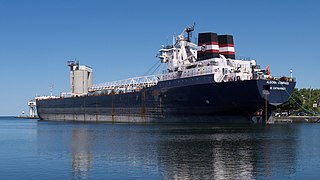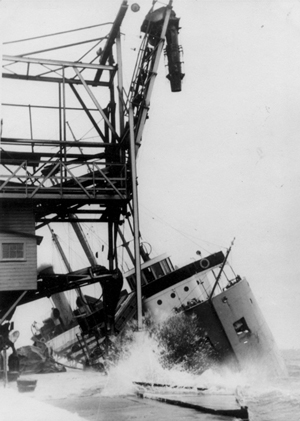
Lake freighters, or lakers, are bulk carrier vessels that ply the Great Lakes of North America. These vessels are traditionally called boats, although classified as ships.
Quebecois was a lake freighter that served the Great Lakes, operating between ports in the United States and Canada. The vessel was launched in 1962 by Canadian Vickers Ltd of Montreal, Quebec, Canada. Used to carry grain and ore, Quebecois was built to the maximum dimensions allowed on the Saint Lawrence Seaway. The vessel entered service in 1963 and in 2012, the ship's named was altered to Algoma Quebecois. The ship was broken up for scrap at Port Colborne, Ontario, Canada in 2013.

MV Algonorth was a Seawaymax lake freighter built in 1970 and completed in 1971 by the Govan Division of Upper Clyde Shipbuilders Ltd. in Govan, Scotland as the bulk carrier Temple Bar. Her original owners were Lambert Bros. Shipping Ltd., of London, United Kingdom, sold the vessel in 1976 to Nipigon Transport Ltd., who had her hull lengthened and installed a new power plant for Great Lakes service. Re-entering service as Lake Nipigon, the ship was renamed Laketon in 1984 before returning to the name Lake Nipigon in 1986. In 1987, the lake freighter was sold to Algoma Central Railway which gave the ship its final named, Algonorth. In 2007, the ship collided with a dock in Toledo, Ohio. The ship was scrapped in 2012.

MV Canadian Miner was a Canadian laker that was part of the fleet of Upper Lakes Shipping from 1994–2011. Initially constructed as Maplecliffe Hall in 1966, the ship was renamed Lemoyne in 1988 before becoming Canadian Miner in 1994. In 2011, the name was shortened to just Miner. In 2011 the vessel was taken out of service and sold for scrapping. While en route to the scrapyard in Turkey, the ship ran aground off Nova Scotia in 2011. The vessel was broken up in 2014 in Nova Scotia.
HMCS Bras d'Or was an auxiliary minesweeper that served in the Royal Canadian Navy (RCN) between 1939 and 1940, when she sank with all hands in a storm. Previous to her service in the RCN, she served as Lightship No. 25 in the Canadian Department of Marine and Fisheries.

Algorail was a lake freighter owned and operated by Algoma Central. The ship was built by Collingwood Shipyards in Collingwood, Ontario and was launched in 1967. The ship sailed on the North American Great Lakes and the Saint Lawrence Seaway delivering coal/coke, aggregates, slag, iron ore/oxides, salt, fertilizers, grain products, gypsum, quartzite, or sand. The ship was laid up in 2016 and sold for scrap in 2018.
Seven Acre Shoal is a navigational hazard at the east end of Lake Ontario, north of Snake Island, and 9 miles (14 km) west of Kingston, Ontario.

Algolake was a self-unloading bulk carrier owned and operated by Algoma Central. The ship entered service in 1977 on the Saint Lawrence Seaway. In 1994, the ship ran aground in the St. Lawrence River off Quebec. The ship was laid up for scrapping in 2018, renamed Gola and was later scrapped in Aliağa, Turkey.

The Quebec and Ontario Transportation Company was a shipping firm in Canada prior to the opening of the St Lawrence Seaway.

Algoma Progress was a self-unloading lake freighter and bulk carrier operating on the North American Great Lakes, owned by Algoma Central. Launched in 1968, the ship was originally named Canadian Progress and operated by the Upper Lakes Shipping. At launch, the ship was the largest self-unloading vessel on the Great Lakes. Canadian Progress was used to transport coal, iron ore, barley and road salt on the Great Lakes and Saint Lawrence Seaway. Canadian Progress ran aground twice, the first in 1985 and then again in 1988. In 2011, Upper Lakes Shipping sold its entire fleet to Algoma Central, which renamed the vessel Algoma Progress. In 2014, Algoma Progress was sold for scrap and broken up at Port Colborne, Ontario.

Whitefish Bay is a self-unloading lake freighter that entered service with Canada Steamship Lines (CSL) in 2013. Built in China, the vessel is the third of CSL's Trillium-class ships. Her sister ships are Baie Comeau, Baie St. Paul and Thunder Bay. Whitefish Bay is used primarily to transport goods on the North American Great Lakes and the St. Lawrence Seaway.

Algoma Compass, formerly Roger M. Kyes and Adam E. Cornelius, is a self-unloading bulk carrier built in Toledo, Ohio in 1973 for the American Steamship Company. The bulk carrier carried bulk cargoes throughout the Great Lakes and St. Lawrence Seaway. The vessel has earned a reputation as a "hard luck" ship, experiencing mechanical failures and groundings. In 2018, the ship was acquired by Algoma Central and put in service as Algoma Compass.

CSL Tadoussac is a lake freighter currently operated by Canada Steamship Lines (CSL) on the Great Lakes. She was launched in 1969. Initially named Tadoussac, following her refit in 2001, she was renamed CSL Tadoussac She was the last freighter built for CSL in the traditional two superstructure design, which puts her bridge up in the ship's bow. The vessel primarily transports iron ore and coal.

Tundra is a bulk carrier. She was launched in 2009. The maritime site boatnerd reports she is operated by Navarone SA of Limassol, Cyprus, and leased to Canfornav Incorporated of Montreal, the Canadian Forest Navigation Group. Marine Link however reports that she is owned by Canfornav.

Radcliffe R. Latimer is a lake freighter launched in 1978. The vessel is owned by Algoma Central but operated under charter to Canada Steamship Lines from 1994 to 1997. As Algobay, the bulk carrier was involved in a collision with another lake freighter in 1980. In 2009 the vessel was rebuilt in China for service in the Caribbean Sea. The vessel is currently in service.
Roy A. Jodrey was a bulk carrier owned by Algoma Central Railway. The ship was launched and entered service in 1965, one of four ships constructed for the company to access ports on the Great Lakes and Saint Lawrence Seaway too small for use by the larger lake freighters. On 20 November 1974, Roy A. Jodrey struck Pullman Shoal in the St. Lawrence River in Alexandria Bay, New York. The vessel made it to the United States Coast Guard Station at Wellesley Island and tied up. At 03:00, the bulk carrier sank in 77 metres (254 ft) of water, with its entire crew reaching safety. No attempt to salvage the ship was made, but Algoma did try to salvage the vessel's cargo of iron ore, which led to the death of a diver. Roy A. Jodrey became a technical scuba diving site, whose difficulty has led to the deaths of a some of those who have attempted it.

Augustus B. Wolvin was a 560 ft (170 m) long Great Lakes freighter that had a 63-year career on the Great Lakes. Augustus B. Wolvin was a product of the American Shipbuilding Company of Cleveland, Ohio. She was built for the Acme Steamship Company of Duluth, Minnesota.

The Henry Phipps was a 601-foot-long (183 m) American Great Lakes freighter that served on the Great Lakes of North America from her launching in 1907 to her scrapping in 1976 by Hyman Michaels Company of Duluth, Minnesota. The Phipps was used to haul bulk cargoes such as iron ore, coal, grain and occasionally limestone.

The SS Lakeland was an early steel-hulled Great Lakes freighter that sank on December 3, 1924, into 205 feet (62 m) of water on Lake Michigan near Sturgeon Bay, Door County, Wisconsin, United States, after she sprang a leak. On July 7, 2015, the wreck of the Lakeland was added to the National Register of Historic Places.

Algosoo was a lake freighter constructed for Algoma Central in 1974 by Collingwood Shipyard in Collingwood, Ontario. The second ship of the name, Algosoo was the last lake freighter built in the traditional design for use on the North American Great Lakes, where the bridge topped a superstructure right in the ship's bow, and a second superstructure topped her engines, right in the stern. The vessel was used to transport bulk cargoes between ports on the Great Lakes. In 1986, the ship suffered a serious fire and 1994, was forced to run aground. Algosoo transported her last cargo in late 2015 and was sailed to the breaking yard at Port Colborne, Ontario in October 2016.
















